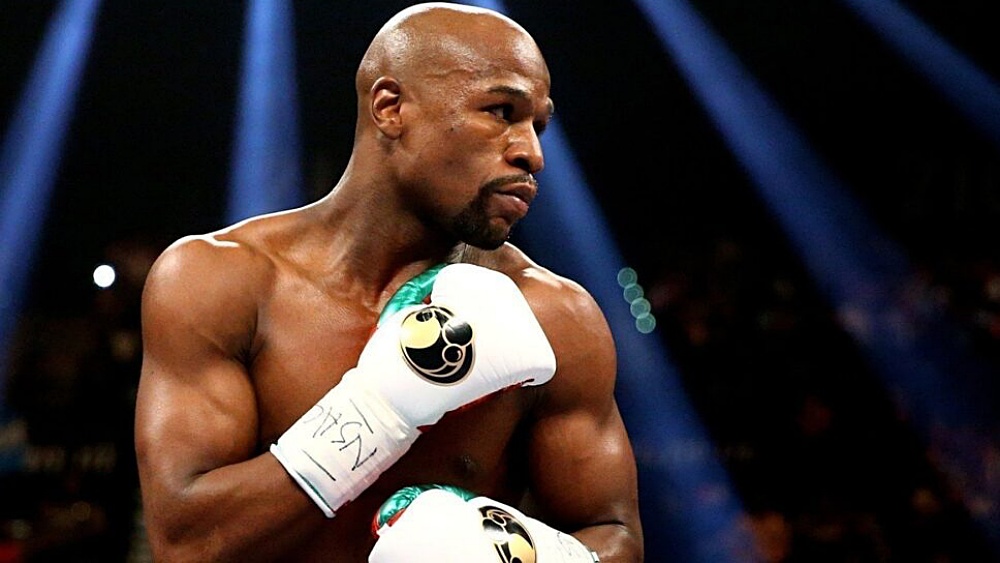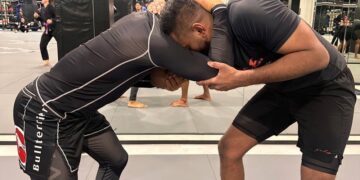
Boxing is perhaps the purest form of combat known to man. Nothing could be simpler than duking it out with nothing but the hands. Despite its inherent simplicity, there are several different styles and tactics a boxer can apply to affect the outcome of a bout. In this article, we will be looking at different guards to study – and their unique strengths and weaknesses within the squared circle.
1) Traditional Boxing Guard
The traditional stance is the most common guard you will see in boxing. The reason for this is its all-around practicality, with the hands being high enough to protect the chin, block hooks, and parry punches. At the same time, the elbows are low enough to block body shots.
The hand position also offers enough flexibility to move the head with relative ease. If the hands are high, bobbing and weaving becomes difficult and cumbersome. When hands are low, head movement becomes easier, but blocking takes slightly longer. This is still the most frequently used of any boxing guards.
Anthony Joshua and Gennady Golovkin are good examples of modern boxers who utilize a traditional stance. It’s a very textbook style that is grounded and covers all bases. The downside is it can be easy to exploit as it is boxing’s most commonly used guard. As such, the traditional stance doesn’t bring any surprises to the table.
2) The Philly Shell Guard
Originally named the “crab shell,” the Philly shell is a unique guard that when used correctly offers a great deal of protection. The lead hand stays low and protects the stomach from body shots, while the right hand stays high to catch jabs and block hooks. Furthermore, the lead hand being low makes it more difficult for your opponent to see jabs coming.
The Philly shell was most famously used by Floyd Mayweather. The problem with this guard is it’s very difficult to use effectively and can often take years to master. Legend has it that even the mighty Floyd took his fair share of licks in the gym en route to perfecting the style. His professional record of 50-0 suggests those efforts were not in vain.
When using this guard, it’s very important to keep your lead shoulder high to protect the chin. Crosses can be deflected using the shoulder roll, creating the opportunity to throw a cross of your own. This tactic is one of Floyd’s signature moves. This is more dangerous against an opponent who is in the opposite stance as it opens you up to their lead hook and crosses down the middle.
3) High Guard
The high guard is most famously used by the legendary Ronald “Winky” Wright – and often used by the likes of Canelo Alvarez and Vasyl Lomachenko. This guard keeps your hands in a prime position to parry straight shots. The parry-to-cross combination is especially effective when your opponent throws a jab from the opposite stance.
It’s important to keep your elbows tucked together to defend against uppercuts. If you are going to use this guard, you will need to have good body conditioning as you are essentially inviting in body attacks. Another downside is the jab has further to travel and is easier for your opponent to see coming.
A tight high guard is very difficult to break but also obscures vision. It also can be seen as a signal to the opponent that you are in survival mode. This is because many boxers revert to it as a way to buy time and recover when they are hurt. The best way to deal with a highly guarded pressure fighter is to maintain distance, attack the body, and keep your back away from the ropes.
4) The Peekaboo Boxing Guard
The Peekaboo guard was the brainchild of Hall of Fame trainer Cus D’Amato – you may know it best as the stance used by his prodigy, “Iron” Mike Tyson. The peekaboo is the perfect stance for smaller stocky fighters. With an emphasis on head movement and relentless forward pressure, this stance is a nightmare for taller fighters.
The key difference between the Peekaboo style and other guards is your toes point forward as opposed to side-on. This grants better left-to-right head movement without throwing you off balance. When doing the peekaboo, it’s important to keep your hands up to your cheeks. Doing so allows your arms to protect your body while the gloves protect your chin.
The downside to the Peekaboo style is that it is predictable and limited, relying heavily on timing and reflexes. Although the partying likely didn’t help, it’s no coincidence that Mike Tyson began to rack up losses as his reflexes began to slow. With the peekaboo being his only style, he was unable to adjust and change tactics.
5) Cross Guard
The cross guard is perhaps the most unusual boxing style mentioned. Although rare, Archie Moore, Ken Norton, and boxing sluggers like George Foreman used it with great success. Joe Frazier also used a variation of the cross guard, although he combined it with constant bobbing and weaving mixed with relentless forward pressure.
The cross guard is exactly how it sounds. You use your arms to form a cross shape in front of your torso. It’s defensively sound but comes at the cost of effective offense, as it’s hard to fire off powerful straight shots from a cross-armed position.
Although the cross guard protects you from uppercuts, the ribs and liver are more exposed – make sure to keep that in mind if you decide to give it a try. Nonetheless, this guard lends itself to an interesting boxing style but takes practice to use effectively.
Conclusion
There are pros and cons to whatever style you use, none are necessarily right or wrong. The likes of Roy Jones Junior and “Prince” Naseem Hamed would sometimes opt for no guard at all, in a bid to goad their opponent. Ultimately, it’s all about the risk-reward ratio you feel most comfortable with.
Experiment with some of these boxing stances and see what works for you. Nothing is set in stone, and you may find it best to learn a few different guards rather than focusing exclusively on one.
You may also like:
How To Shoeshine In Boxing
There are a myriad of fighting styles in boxing, from the evasive Philly Shell style Floyd Mayweather uses to the aggressive Peekaboo style of Mike Tyson. Regardless of their individual style, skilled boxers share one…
Boxing is one of the most globalized combat sports, and the top boxers remain some of the highest-paid athletes in the world. Anyone can master the sweet science and enjoy the many rewards that come…
BJJ is often called “human chess” because it works the body and mind simultaneously. This fact is highlighted as you become more experienced and start facing better opponents, and you start seeing more of the…
The Peekaboo style of boxing is one that is unique in its concepts and execution in the ring. It was first developed by Constantine “Cus” D’amato, trainer to the legendary Mike Tyson. Focusing on a…
Combat sports like Boxing, Muay Thai, and Kickboxing are more cerebral than most people think. Yes, physical attributes like power, speed, and explosiveness go a long way, but what happens when these things cancel out?…
In the world of boxing, a solid and agile upper body is essential for delivering powerful punches and defending against opponents. To achieve peak performance in the ring, boxers must focus on cultivating upper body…
The martial arts of Muay Thai and Lethwei are deeply ingrained into the history and national identity of the neighbouring countries, Thailand and Myanmar (formerly Burma) respectively. The fact that these countries share a border…
Have you ever wondered why so many people get hooked on Brazilian Jiu-Jitsu? There are plenty of reasons why people who train Brazilian Jiu-Jitsu keep coming back. The traditional martial art continues to evolve and…
Singapore, often referred to as the “Garden City,” offers a unique blend of urban modernity and verdant nature. Despite its cosmopolitan nature, Singapore boasts numerous reservoir hiking trails that are sure to rejuvenate your mind,…
Building a complete guard game in Jiu-Jitsu takes many hours of learning and experimentation. Similar to building the foundation of a house, your guard should be able to withstand threats from all sides and hold…
The clinch is an essential aspect for any MMA fighter. It is the range of combat between stand-up striking and grappling on the floor. Strikers can utilize the clinch to keep the fight standing and…
Pinning the opponent is one of the most essential skills in grappling, including Brazilian Jiu-Jitsu. To define, a pin is where you use your body configuration and gravity to control a fully resisting opponent. Renowned…


































